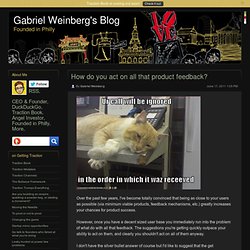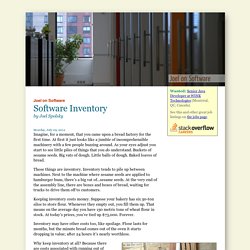

Startup Priorities - Geoff's Blog. One of the most difficult tasks for a startup founder is deciding what to do.

Where should the tiny number of people working on a brand new company spend their time? Choosing wisely can place your company on the road to success. Spending too much time on the wrong things can condemn the startup to an early death. How do you know whether you are making the right decisions in time for your company to not die? Usually, my answer to founder questions such as “how should I be spending my time?”
This is simple and sometimes enlightening. There is also a special case where you are trying to decide what to build. (b * d) / c b tells you how many of your users, current or new, will be impacted by a new feature, d describes how important that feature will be to the average user, and c gives you how hard it is to build the feature. Naturally, it can be difficult or impossible to accurately estimate each of the above variables. How to build a solid product roadmap: Part 1. Recently, I’ve spent more time mentoring and managing junior PMs and the other day one posed a deceitfully simple question: how do you build a good roadmap?

At first blush, it seems like an easy question to answer. Consider what your current customer base wants, what unmet needs they still have, what your product vision is, how it aligns with company strategy, what new capabilities exist (or will exist) that you can take advantage of, what your engineering team wants to build, your sales team, your UX team, and so on. You could answer those questions and build a roadmap. In fact, you could just stack rank a list of features you have on your to-do list, team idea wall, hack-a-thon whiteboard, or brainstorming area.
That would make a roadmap. You need a framework to get there. One way to think about this is in terms of trends and beliefs. If you map this out, it looks like this: The framework does not provide the answer. Kudos. How do you act on all that product feedback? Over the past few years, I've become totally convinced that being as close to your users as possible (via minimum viable products, feedback mechanisms, etc.) greatly increases your chances for product success.

However, once you have a decent sized user base you immediately run into the problem of what do with all that feedback. The suggestions you're getting quickly outpace your ability to act on them, and clearly you shouldn't act on all of them anyway. I don't have the silver bullet answer of course but I'd like to suggest that the get satisfaction model of counting up the ones with the most votes and acting on them in that order may not be your best move in all cases.
Consider the following: Really small changes/tweaks can make a big difference. Both are certainly viable strategies and have led to many successes. The reason is that delivering features people ask for is the path of least resistance. And that's the key. Software Inventory. By Joel Spolsky Monday, July 09, 2012 Imagine, for a moment, that you came upon a bread factory for the first time.

At first it just looks like a jumble of incomprehensible machinery with a few people buzzing around. As your eyes adjust you start to see little piles of things that you do understand. Buckets of sesame seeds. Those things are inventory. Keeping inventory costs money. Inventory may have other costs too, like spoilage. Why keep inventory at all? Why do I care about any of this? “What? Think of product ideas as the raw material.
A decision-making process (should we implement this feature?) (PS No, this is not “waterfall.” In between each of these stages, inventory can pile up. The “cost” of code inventory is huge. Let’s go over the three places most inventory accumulates. Feature backlogs. The trouble is that 90% of the things in the feature backlog will never get implemented, ever. Suggestion: Do not allow more than a month or two of work to get into the feature backlog list.